Abstract
Angle-closure glaucoma is an aggressive condition that causes millions to become blind worldwide. This review explores the use of prophylactic laser peripheral iridotomy (PI) in patients classified as primary angle-closure suspects (PACS), and additionally, the use of clear lens exchange as a primary treatment option in established angle-closure disease with or without glaucoma. As PI has a strong prophylactic effect in fellow eyes of patients who have had an acute attack, its use has been widely adopted in those patients classified as PACS, but with limited evidence to support this. A large randomised trial conducted in China has demonstrated that although PI reduces the risk of incident angle-closure disease, the incidence of disease that would threaten vision was much lower than anticipated. This suggests that the benefit of prophylactic PI is very limited. Health services data shows an association between rising cataract surgical rates and of decreasing rates of acute angle-closure. Age-related growth of the lens is a major component of angle-closure disease. Several studies have shown that clear lens extraction (CLE) effectively lowers IOP in angle-closure. The use of CLE as a primary treatment option has been tested against LPI in the EAGLE study, a large RCT that enroled people with angle-closure and an IOP > 30 mmHg, and those with angle-closure glaucoma. The trial showed CLE to be superior to PI both for IOP control and patient reported quality of life. On these grounds, CLE should be considered for first-line treatment of more advanced angle-closure disease.
摘要
原发性闭角型青光眼已成为严峻的社会公共卫生问题, 已引起全球百万人致盲 。本文旨在探讨预防性激光周边虹膜切除术(PI)在可疑原发性房角关闭(PACS)患者中的作用, 此外, 对于已确诊的伴或不伴有青光眼的原发性房角关闭的患者, 是否首选清亮晶状体摘除术。研究已证实预防性激光周边虹膜切除术(PI)可有效预防既往有急性发作史的患者对侧眼发作, 因此PI现已广泛应用于PACS的治疗, 但是尚缺乏更多有效证据。一项中国大型随机试验证实, 尽管PI降低了房角关闭发生的风险, 但是并未降低威胁视力的眼病的发病率, 这说明预防性PI的作用还是有限的。卫生服务数据提示白内障手术率的增加与急性房角关闭发生率下降具有相关性。随年龄增加晶体的改变与房角关闭具有相关性。多项研究表明, 尚未混浊的晶体摘除术 (CLE)可以有效降低房角关闭的眼压。在EAGLE研究中, 将CLE作为主要治疗方案与LPI进行了比较。这项大型的RCT研究纳入了闭角型青光眼患者与IOP > 30mmHg的房角关闭患者。研究认为在控制眼压以及提高生活质量方面, CLE较PI具有明显优势。因此, CLE可考虑作为严重房角关闭的一线治疗。
Similar content being viewed by others
Login or create a free account to read this content
Gain free access to this article, as well as selected content from this journal and more on nature.com
or
References
Chan MPY, Broadway DC, Khawaja AP, Yip JLY, Garway-Heath DF, Burr JM, et al. Glaucoma and intraocular pressure in EPIC-Norfolk Eye Study: cross sectional study. BMJ. 2017;358:j3889.
Quigley HA, Broman AT. The number of people with glaucoma worldwide in 2010 and 2020. Br J Ophthalmol. 2006;90:262–7.
Tham Y-C, Li X, Wong TY, Quigley HA, Aung T, Cheng C-Y. Global prevalence of glaucoma and projections of glaucoma burden through 2040. Ophthalmology. 2014;121:2081–90.
Foster PJ, Johnson GJ. Glaucoma in China: how big is the problem? Br J Ophthalmol. 2001;85:1277–82.
Foster PJ, Buhrmann R, Quigley HA, Johnson GJ. The definition and classification of glaucoma in prevalence surveys. Br J Ophthalmol. 2002;86:238–42.
Marchini G, Chemello F, Berzaghi D, Zampieri A. New findings in the diagnosis and treatment of primary angle-closure glaucoma. Prog Brain Res. 2015;221:191–212.
Schwartz LW, Rodrigues MM, Spaeth GL, Streeten B, Douglas C. Argon laser iridotomy in the treatment of patients with primary angle-closure or pupillary block glaucoma: a clinicopathologic study. Ophthalmology. 1978;85:294–309.
Fankhauser F, der Zypen E. Future of the laser in ophthalmology. Trans Ophthalmol Soc U K. 1982;159:159–63.
Prum BE, Herndon LW, Moroi SE, Mansberger SL, Stein JD, Lim MC, et al. Primary angle closure preferred practice pattern® guidelines. Ophthalmology. 2016;123:P1–40.
Weinreb RN, Friedman DS (eds). Angle closure and angle-closure glaucoma. NL: Kugler Publications; 2006.
Greve EL. Primary angle closure glaucoma: extracapsular cataract extraction or filtering procedure? Int Ophthalmol. 1988;12:157–62.
Gunning FP, Greve EL. Uncontrolled primary angle closure glaucoma: results of early intercapsular cataract extraction and posterior chamber lens implantation. Int Ophthalmol. 1991;15:237–47.
Gunning FP, Greve EL. Lens extraction for uncontrolled angle-closure glaucoma: long-term follow-up. J Cataract Refract Surg. 1998;24:1347–56.
Yang CH, Hung PT. Intraocular lens position and anterior chamber angle changes after cataract extraction in eyes with primary angle-closure glaucoma. J Cataract Refract Surg. 1997;23:1109–13.
Lai JSM, Tham CCY, Chan JCH. The clinical outcomes of cataract extraction by phacoemulsification in eyes with primary angle-closure glaucoma (PACG) and co-existing cataract: a prospective case series. J Glaucoma. 2006;15:47–52.
Jacobi PC, Dietlein TS, Lüke C, Engels B, Krieglstein GK. Primary phacoemulsification and intraocular lens implantation for acute angle-closure glaucoma. Ophthalmology. 2002;109:1597–603.
Hu C-C, Lin H-C, Chen C-S, Kuo N-W. Reduction in admissions of patients with acute primary angle closure occurring in conjunction with a rise in cataract surgery in Taiwan. Acta Ophthalmol. 2008;86:440–5.
Keenan TDL, Salmon JF, Yeates D, Goldacre M. Trends in rates of primary angle closure glaucoma and cataract surgery in England from 1968 to 2004. J Glaucoma. 2009;18:201–5.
Day AC, Foster PJ. Increases in rates of both laser peripheral iridotomy and phacoemulsification have accompanied a fall in acute angle closure rates in the UK. Br J Ophthalmol. 2011;95:1339–40.
Gillan SN, Wilson PJ, Knight DS, Sanders R. Trends in acute primary angle-closure glaucoma, peripheral iridotomy and cataract surgery in Scotland, 1998–2012. Ophthalmic Epidemiol. 2016;23:1–5.
Devereux JG, Foster PJ, Baasanhu J, Uranchimeg D, Lee P-S, Erdenbeleig T, et al. Anterior chamber depth measurement as a screening tool for primary angle-closure glaucoma in an East Asian population. Arch Ophthalmol. 2000;118:257.
Foster PJ, Devereux JG, Alsbirk PH, Lee PS, Uranchimeg D, Machin D, et al. Detection of gonioscopically occludable angles and primary angle closure glaucoma by estimation of limbal chamber depth in Asians: modified grading scheme. Br J Ophthalmol. 2000;84:186–92.
Alsbirk PH. Primary angle-closure glaucoma. Oculometry, Epidemiol, Genet a high risk Popul Acta Ophthalmol Suppl. 1976;127:5–31.
Sheth HG, Goel R, Jain S. UK national survey of prophylactic YAG iridotomy. Eye. 2005;19:981–4.
Teikari J, Raivio I, Nurminen M. Incidence of acute glaucoma in Finland from 1973 to 1982. Graefe’s Arch Clin Exp Ophthalmol. 1987;225:357–60.
Ivanisević M, Erceg M, Smoljanović A, Trosić Z. The incidence and seasonal variations of acute primary angle-closure glaucoma. Coll Antropol. 2002;26:41–5.
Bojić L, Mandić Z, Ivanisević M, Bucan K, Kovacević S, Gverović A, et al. Incidence of acute angle-closure glaucoma in Dalmatia, southern Croatia. Croat Med J. 2004;45:279–82.
David R, Tessler Z, Yassur Y. Epidemiology of acute angle-closure glaucoma: incidence and seasonal variations. Ophthalmologica. 1985;191:4–7.
Chua PY, Day AC, Lai KL, Hall N, Tan LL, Khan K, et al. The incidence of acute angle closure in Scotland: a prospective surveillance study. Br J Ophthalmol. 2017;102:539–43.
Wong TY, Foster PJ, Seah SK, Chew PT. Rates of hospital admissions for primary angle closure glaucoma among Chinese, Malays, and Indians in Singapore. Br J Ophthalmol. 2000;84:990–2.
Seah SKL, Foster PJ, Chew PTK, Jap A, Oen F, Fam HB, et al. Incidence of acute primary angle-closure glaucoma in Singapore. Arch Ophthalmol. 1997;115:1436.
Wilensky JT, Kaufman PL, Frohlichstein D, Gieser DK, Kass MA, Ritch R, et al. Follow-up of angle-closure glaucoma suspects. Am J Ophthalmol. 1993;115:338–46.
Thomas R, George R, Parikh R, Muliyil J, Jacob A. Five year risk of progression of primary angle closure suspects to primary angle closure: a population based study. Br J Ophthalmol. 2003;87:450–4.
Foster PJ, Baasanhu J, Alsbirk PH, Munkhbayar D, Uranchimeg D, Johnson GJ. Glaucoma in Mongolia. Arch Ophthalmol. 1996;114:1235.
Nolan WP, Foster PJ, Devereux JG, Uranchimeg D, Johnson GJ, Baasanhu J. YAG laser iridotomy treatment for primary angle closure in east Asian eyes. Br J Ophthalmol. 2000;84:1255–9.
Nolan WP, Baasanhu J, Undraa A, Uranchimeg D, Ganzorig S, Johnson GJ. Screening for primary angle closure in Mongolia: a randomised controlled trial to determine whether screening and prophylactic treatment will reduce the incidence of primary angle closure glaucoma in an east Asian population. Br J Ophthalmol. 2003;87:271–4.
Yip JLY, Foster PJ, Uranchimeg D, Javzandulam B, Javzansuren D, Munhzaya T, et al. Randomised controlled trial of screening and prophylactic treatment to prevent primary angle closure glaucoma. Br J Ophthalmol. 2010;94:1472–7.
He M, Foster PJ, Ge J, Huang W, Zheng Y, Friedman DS, et al. Prevalence and clinical characteristics of glaucoma in adult Chinese: a population-based study in Liwan district, Guangzhou. Invest Opthalmol Vis Sci. 2006;47:2782.
He M, Foster PJ, Ge J, Huang W, Wang D, Friedman DS, et al. Gonioscopy in adult Chinese: The Liwan Eye Study. Invest Opthalmol Vis Sci. 2006;47:4772.
He M, Friedman DS, Ge J, Huang W, Jin C, Lee PS, et al. Laser peripheral iridotomy in primary angle-closure suspects: biometric and gonioscopic outcomes. Ophthalmology. 2007;114:494–500.
He M, Jiang Y, Huang S, Chang DS, Munoz B, Aung T, et al. Laser peripheral iridotomy for the prevention of angle closure: a single-centre, randomised controlled trial. Lancet. 2019;393:1609–18.
Wang N, Ouyang J, Zhou W, Lai M, Ye T, Zeng M, et al. Multiple patterns of angle closure mechanisms in primary angle closure glaucoma in Chinese. Zhonghua Yan Ke Za Zhi. 2000;36:46–51.
Sun X, Dai Y, Chen Y, Yu D-Y, Cringle SJ, Chen J, et al. Primary angle closure glaucoma: what we know and what we don’t know. Prog Retin Eye Res. 2017;57:26–45.
He M, Foster PJ, Johnson GJ, Khaw PT. Angle-closure glaucoma in East Asian and European people. Different diseases? Eye. 2006;20:3–12.
Saw S-M, Gazzard G, Friedman DS. Interventions for angle-closure glaucoma. Ophthalmology. 2003;110:1869–79.
Chen H-Y, Lin C-L, Lai S-W, Kao C-H. Association of selective serotonin reuptake inhibitor use and acute angle–closure glaucoma. J Clin Psychiatry. 2016;77:e692–6.
Subak-Sharpe I, Low S, Nolan W, Foster PJ. Pharmacological and environmental factors in primary angle-closure glaucoma. Br Med Bull. 2010;93:125–43.
Amerasinghe N, Zhang J, Thalamuthu A, He M, Vithana EN, Viswanathan A, et al. The heritability and sibling risk of angle closure in Asians. Ophthalmology. 2011;118:480–5.
Rudkin AK, Gray TL, Awadalla M, Craig JE. Bilateral simultaneous acute angle closure glaucoma precipitated by non-prescription cold and flu medication. Emerg Med Australas. 2010;22:477–9.
Barrett V, Jordan T. Angle closure risk from proprietary medicines. Eye. 2001;15:248–9.
Lai JS, Liu DT, Tham CC, Li RT, Lam DS. Epidemiology of acute primary angle-closure glaucoma in the Hong Kong Chinese population: prospective study. Hong Kong Med J. 2001;7:118–23.
Turnbull AMJ, Smith M, Ramchandani M. Angle-closure glaucoma on long-haul flights. JAMA Ophthalmol. 2014;132:1474.
Wolfs RC, Grobbee DE, Hofman A, de Jong PT. Risk of acute angle-closure glaucoma after diagnostic mydriasis in nonselected subjects: the Rotterdam Study. Invest Ophthalmol Vis Sci. 1997;38:2683–7.
Liew G, Mitchell P, Wang JJ, Wong TY. Fundoscopy: to dilate or not to dilate? BMJ. 2006;332:3.
Mapstone R. Normal response to pilocarpine and phenylephrine. Br J Ophthalmol. 1977;61:510–1.
Mapstone R. Dilating dangerous pupils. Br J Ophthalmol. 1977;61:517–24.
Foster PJ, Oen FT, Machin D, Ng TP, Devereux JG, Johnson GJ, et al. The prevalence of glaucoma in Chinese residents of Singapore: a cross-sectional population survey of the Tanjong Pagar district. Arch Ophthalmol. 2000;118:1105–11.
Friedman D, Vedula SS. Lens extraction for chronic angle-closure glaucoma. Cochrane Database Syst Rev. 2006; CD005555.
Melese E, Peterson JR, Feldman RM, Baker LA, Bell NP, Chuang AZ, et al. Comparing laser peripheral iridotomy to cataract extraction in narrow angle eyes using anterior segment optical coherence tomography. PLoS ONE. 2016;11:e0162283.
Lam DSC, Leung DYL, Tham CCY, Li FCH, Kwong YYY, Chiu TYH, et al. Randomized trial of early phacoemulsification versus peripheral iridotomy to prevent intraocular pressure rise after acute primary angle closure. Ophthalmology. 2008;115:1134–40.
Husain R, Gazzard G, Aung T, Chen Y, Padmanabhan V, Oen F, et al. Initial management of acute primary angle closure: a randomized trial comparing phacoemulsification with laser peripheral iridotomy. Ophthalmology. 2012;119:2274–81.
Masis M, Mineault PJ, Phan E, Lin SC. The role of phacoemulsification in glaucoma therapy: a systematic review and meta-analysis. Surv Ophthalmol. 2018;63:700–10.
Dada T, Rathi A, Angmo D, Agarwal T, Vanathi M, Khokhar SK, et al. Clinical outcomes of clear lens extraction in eyes with primary angle closure. J Cataract Refract Surg. 2015;41:1470–7.
Tham CC, Kwong YY, Baig N, Leung DY, Li FC, Lam DS. Phacoemulsification versus trabeculectomy in medically uncontrolled chronic angle-closure glaucoma without cataract. Ophthalmology. 2013;120:62–7
Tham CCY, Leung DYL, Kwong YYY, Liang Y, Peng AY, Li FCH, et al. Factors correlating with failure to control intraocular pressure in primary angle-closure glaucoma eyes with coexisting cataract treated by phacoemulsification or combined phacotrabeculectomy. Asia-Pac J Ophthalmol. 2015;4:56–9.
Javanbakht M, Azuara-Blanco A, Burr JM, Ramsay C, Cooper D, Cochran C, et al. Early lens extraction with intraocular lens implantation for the treatment of primary angle closure glaucoma: an economic evaluation based on data from the EAGLE trial. BMJ Open. 2017;7:e013254.
Powe NR, Schein OD, Gieser SC, Tielsch JM, Luthra R, Javitt J, et al. Synthesis of the literature on visual acuity and complications following cataract extraction with intraocular lens implantation. Arch Ophthalmol. 1994;112:239–52.
Shams PN, Foster PJ. Clinical outcomes after lens extraction for visually significant cataract in eyes with primary angle closure. J Glaucoma. 2011;21:545–50.
Day AC, MacLaren RE, Bunce C, Stevens J, Foster P. Outcomes of phacoemulsification and intraocular lens implantation in microphthalmos and nanophthalmos. J Cataract Refract Surg. 2013;39:87–96.
Klein BEK, Klein R, Lee KE. Incidence of age-related cataract over a 10-year interval: the Beaver Dam Eye Study. Ophthalmology. 2002;109:2052–7.
Shields SR. Managing eye disease in primary care. Part 3. When to refer for ophthalmologic care. Postgrad Med. 2000;108:99–106.
Cantor LB. Medical management of glaucoma. In: Basic and clinical science course (BCSC)—Section 10: Glaucoma. SF, USA: Am Acad Ophthalomol; 2005, p. 157–77.
Lam DSC, Chua JKH, Tham CCY, Lai JSM. Efficacy and safety of immediate anterior chamber paracentesis in the treatment of acute primary angle-closure glaucoma: a pilot study. Ophthalmology. 2002;109:64–70.
Arnavielle S, Creuzot-Garcher C, Bron AM. Anterior chamber paracentesis in patients with acute elevation of intraocular pressure. Graefe’s Arch Clin Exp Ophthalmol. 2007;245:345–50.
Ritch R, Tham CCY, Lam DSC. Argon laser peripheral iridoplasty (ALPI): an update. Surv Ophthalmol. 2007;52:279–88.
Lam DSC, Lai JSM, Tham CCY, Chua JKH, Poon ASY. Argon laser peripheral iridoplasty versus conventional systemic medical therapy in treatment of acute primary angle-closure glaucoma: a prospective, randomized, controlled trial. Ophthalmology. 2002;109:1591–6.
Manna A, Foster P, Papadopoulos M, Nolan W. Cyclodiode laser in the treatment of acute angle closure. Eye. 2012;26:742–5.
Quigley HA. Long-term follow-up of laser iridotomy. Ophthalmology. 1981;88:218–24.
Robin AL, Pollack IP. Argon laser peripheral iridotomies in the treatment of primary angle closure glaucoma: long-term follow-Up. Arch Ophthalmol. 1982;100:919–23.
Choong YF, Irfan S, Menage MJ. Acute angle closure glaucoma: an evaluation of a protocol for acute treatment. Eye. 1999;13:613–6.
Harasymowycz PJ, Papamatheakis DG, Ahmed I, Assalian A, Lesk M, Al-Zafiri Y, et al. Phacoemulsification and goniosynechialysis in the management of unresponsive primary angle closure. J Glaucoma. 2005;14:186–9.
Teekhasaenee C, Ritch R. Combined phacoemulsification and goniosynechialysis for uncontrolled chronic angle-closure glaucoma after acute angle-closure glaucoma. Ophthalmology. 1999;106:669–75.
Husain R, Do T, Lai J, Kitnarong N, Nongpiur, Perera S, et al. Efficacy of phacoemulsification alone vs phacoemulsification with goniosynechialysis in patients with primary angle-closure disease: a randomized clinical trial. JAMA Ophthalmol. Published online 11 July, 2019. https://doi.org/10.1001/jamaophthalmol.2019.2493.
Gazzard G, Konstantakopoulou E, Garway-Heath D, Garg A, Vickerstaff V, Hunter R, et al. Selective laser trabeculoplasty versus eye drops for first-line treatment of ocular hypertension and glaucoma (LiGHT): a multicentre randomised controlled trial. Lancet. 2019;393:1505–16.
Author information
Authors and Affiliations
Corresponding author
Ethics declarations
Conflict of interest
The authors declare that they have no conflict of interest.
Additional information
Publisher’s note Springer Nature remains neutral with regard to jurisdictional claims in published maps and institutional affiliations.
Rights and permissions
About this article
Cite this article
Tanner, L., Gazzard, G., Nolan, W.P. et al. Has the EAGLE landed for the use of clear lens extraction in angle-closure glaucoma? And how should primary angle-closure suspects be treated?. Eye 34, 40–50 (2020). https://doi.org/10.1038/s41433-019-0634-5
Received:
Revised:
Accepted:
Published:
Issue Date:
DOI: https://doi.org/10.1038/s41433-019-0634-5
This article is cited by
-
Analysis of anterior segment in primary angle closure suspect with deep learning models
BMC Medical Informatics and Decision Making (2024)
-
Inhibition of cGAS–STING pathway alleviates neuroinflammation-induced retinal ganglion cell death after ischemia/reperfusion injury
Cell Death & Disease (2023)
-
NLRP12 collaborates with NLRP3 and NLRC4 to promote pyroptosis inducing ganglion cell death of acute glaucoma
Molecular Neurodegeneration (2020)



